Accounting: Liability, Bad Debts, Taxes, Repairs
Added on 2023-03-17
26 Pages2344 Words100 Views
ACCOUNTING 1
ACCOUNTING
ACCOUNTING
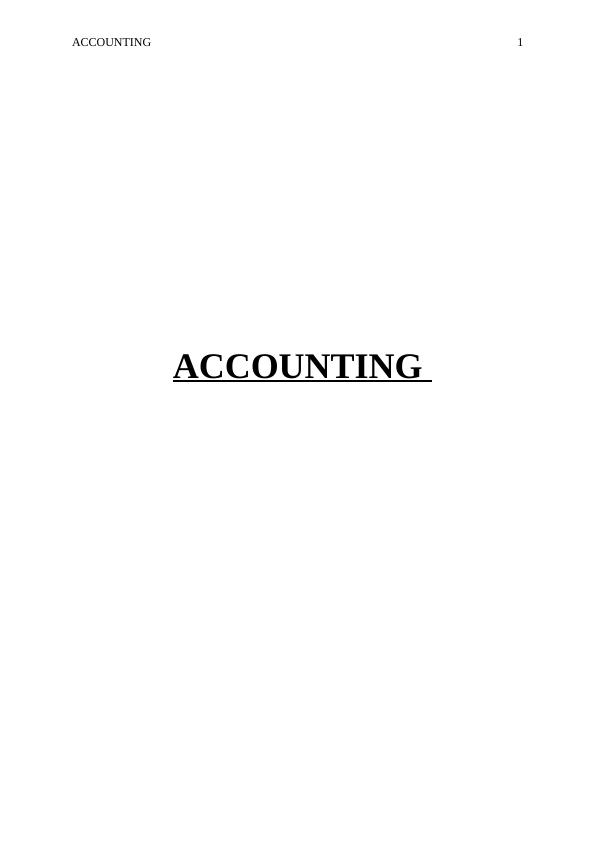
ACCOUNTING 2
Answer 1:
Part 1:
A liability is something which has some present obligation for the company and which also
entails an outflow of the resources. This are connected with the future economic benefits that
flow out of the company. A liability would be recorded in the books of accounts in case there
is a probability of an event to take place and it is more than probable that the event would
happen. In the case, wherein there is no existence of the present obligation, then the company
shall record that expense as a contingent liability. In the cases, wherein there are some similar
obligations of an outflow if the expenses such as the product warranties or such similar
obligations, then the company shall keep a provision for them. The company shall record the
expense as provision when there is a probability that there should be an outflow of the money
for the company in future (AASB, 2019).
Hence, in such a case the warranty expense shall be provided for in the financial statements.
The accounting entry for it would be credit profit and loss account and debit provision for
warranty with an amount of $34,400. The disclosure for this would be the provision for
warranty amount in the notes to the financial statements.
Part 2:
The company would always create a provision for the bad debts out of its total amount of the
accounts receivables. The provision for doubtful expense would be debited if there is any
actual bad debt expense which occurs. Hence, in such a case the entry would be debit
provision for doubtful debts and credit bad debt expense with an amount of $380,000. The
disclosure would be the fact of the actual bad debt loss that the company has suffered during
the year.
Part 3:
Answer 1:
Part 1:
A liability is something which has some present obligation for the company and which also
entails an outflow of the resources. This are connected with the future economic benefits that
flow out of the company. A liability would be recorded in the books of accounts in case there
is a probability of an event to take place and it is more than probable that the event would
happen. In the case, wherein there is no existence of the present obligation, then the company
shall record that expense as a contingent liability. In the cases, wherein there are some similar
obligations of an outflow if the expenses such as the product warranties or such similar
obligations, then the company shall keep a provision for them. The company shall record the
expense as provision when there is a probability that there should be an outflow of the money
for the company in future (AASB, 2019).
Hence, in such a case the warranty expense shall be provided for in the financial statements.
The accounting entry for it would be credit profit and loss account and debit provision for
warranty with an amount of $34,400. The disclosure for this would be the provision for
warranty amount in the notes to the financial statements.
Part 2:
The company would always create a provision for the bad debts out of its total amount of the
accounts receivables. The provision for doubtful expense would be debited if there is any
actual bad debt expense which occurs. Hence, in such a case the entry would be debit
provision for doubtful debts and credit bad debt expense with an amount of $380,000. The
disclosure would be the fact of the actual bad debt loss that the company has suffered during
the year.
Part 3:
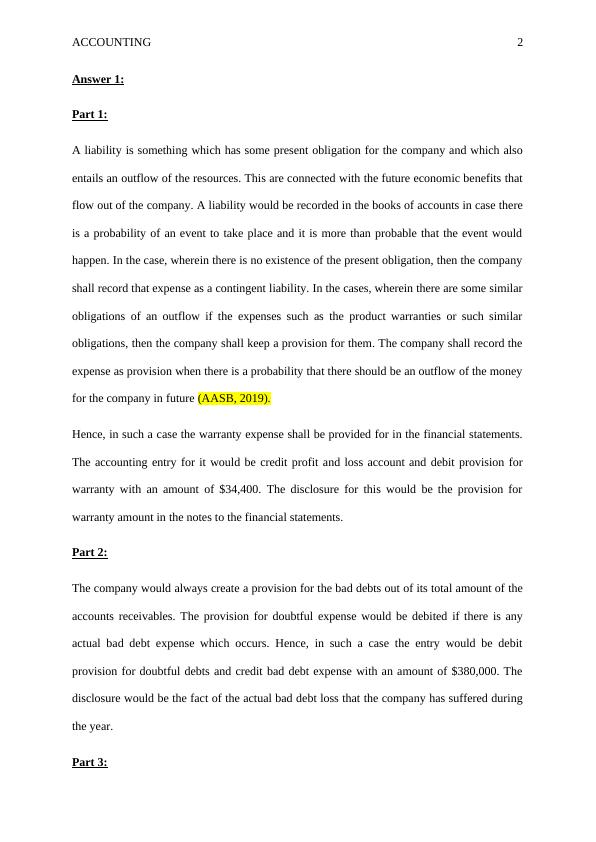
ACCOUNTING 3
If the government of the country in which the company operates goes inti change the rate at
which the taxes are paid, then there would be disclosure requirement for the company. This is
mainly due to the fact that the company would have the pay the taxes at the changed tax rate
and that would be done in the end of the year. The company could though reduce its
provision for taxes as per the amended tax rate. In the given case, the company would reduce
its provision as per the changed tax rate from 30 to 28%.
There is no requirement of any additional disclosure for the company.
Part 4:
Whenever any amount of expense is incurred for an asset, then it has to be determined if that
expense would go on to increase the productivity or the life of the asset. In case, as the result
of those repairs, the life of the asset or its productivity improves, then that would be
capitalised in the cost of the asset. This means that on that expense, the company shall charge
depreciation. But if that expense merely provides some minor changes in the machine, then
that would be charged as against the profit and loss in the current month. The expense shall
be considered as repairs. The relevant disclosure in this case shall be the amount charged as
an expense or the capitalised amount. The relevant journal entry shall be repairs expense
debit with profit and loss credit and in case of capitalisation, machine or asset account debit
with profit and cash credit (IAS plus, 2019).
Journal entries:
Repairs expense Dr 22,000
To Trailer 22,000
Income tax receivable Dr 6,300
To Income tax 6,300
If the government of the country in which the company operates goes inti change the rate at
which the taxes are paid, then there would be disclosure requirement for the company. This is
mainly due to the fact that the company would have the pay the taxes at the changed tax rate
and that would be done in the end of the year. The company could though reduce its
provision for taxes as per the amended tax rate. In the given case, the company would reduce
its provision as per the changed tax rate from 30 to 28%.
There is no requirement of any additional disclosure for the company.
Part 4:
Whenever any amount of expense is incurred for an asset, then it has to be determined if that
expense would go on to increase the productivity or the life of the asset. In case, as the result
of those repairs, the life of the asset or its productivity improves, then that would be
capitalised in the cost of the asset. This means that on that expense, the company shall charge
depreciation. But if that expense merely provides some minor changes in the machine, then
that would be charged as against the profit and loss in the current month. The expense shall
be considered as repairs. The relevant disclosure in this case shall be the amount charged as
an expense or the capitalised amount. The relevant journal entry shall be repairs expense
debit with profit and loss credit and in case of capitalisation, machine or asset account debit
with profit and cash credit (IAS plus, 2019).
Journal entries:
Repairs expense Dr 22,000
To Trailer 22,000
Income tax receivable Dr 6,300
To Income tax 6,300
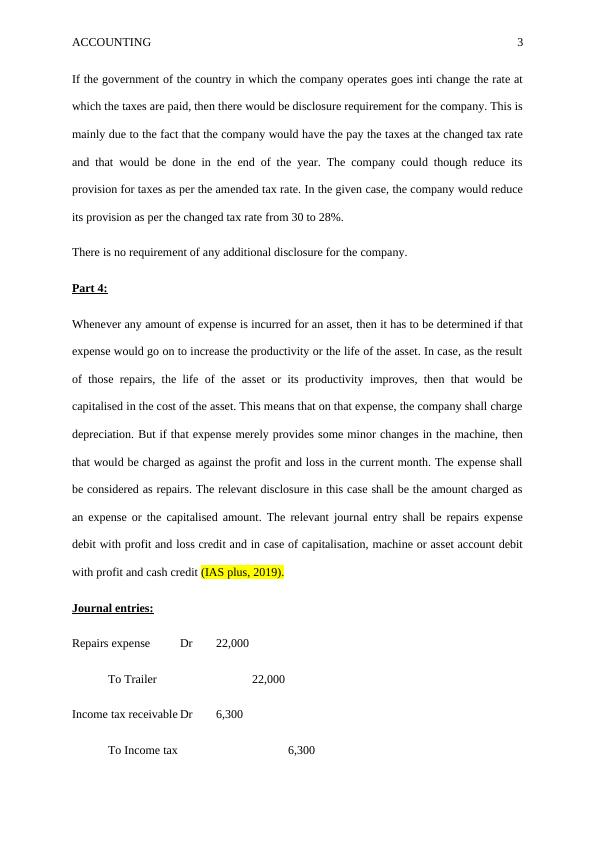
ACCOUNTING 4
Accumulated depreciation Dr 1,000
To Depreciation expense 1,000
Answer 2:
The following are the relevant calculations:
Date
31-Mar-19 Bank A/c
D
r.
1
6,
00
,0
00
To Preference Share Application A/c
Cr
.
16,
00,
000
(Being share application money received
on 800,000 shares @ $2 per share)
31-Mar-19 Bank A/c
D
r.
8
8,
00
,0
00
To Ordinary Share Application A/c Cr
. 88,
Accumulated depreciation Dr 1,000
To Depreciation expense 1,000
Answer 2:
The following are the relevant calculations:
Date
31-Mar-19 Bank A/c
D
r.
1
6,
00
,0
00
To Preference Share Application A/c
Cr
.
16,
00,
000
(Being share application money received
on 800,000 shares @ $2 per share)
31-Mar-19 Bank A/c
D
r.
8
8,
00
,0
00
To Ordinary Share Application A/c Cr
. 88,

ACCOUNTING 5
00,
000
(Being share application money received
on 2,200,000 shares @ $4 per share)
15-Apr-19 Preference Share Application A/c
D
r.
1
6,
00
,0
00
To Preference Share Capital A/c
Cr
.
16,
00,
000
(Being appropriation of application money
towards share capital)
15-Apr-19 Ordinary Share Application A/c
D
r.
8
8,
00
,0
00
To Ordinary Share Capital A/c Cr
. 80,
00,
00,
000
(Being share application money received
on 2,200,000 shares @ $4 per share)
15-Apr-19 Preference Share Application A/c
D
r.
1
6,
00
,0
00
To Preference Share Capital A/c
Cr
.
16,
00,
000
(Being appropriation of application money
towards share capital)
15-Apr-19 Ordinary Share Application A/c
D
r.
8
8,
00
,0
00
To Ordinary Share Capital A/c Cr
. 80,
00,
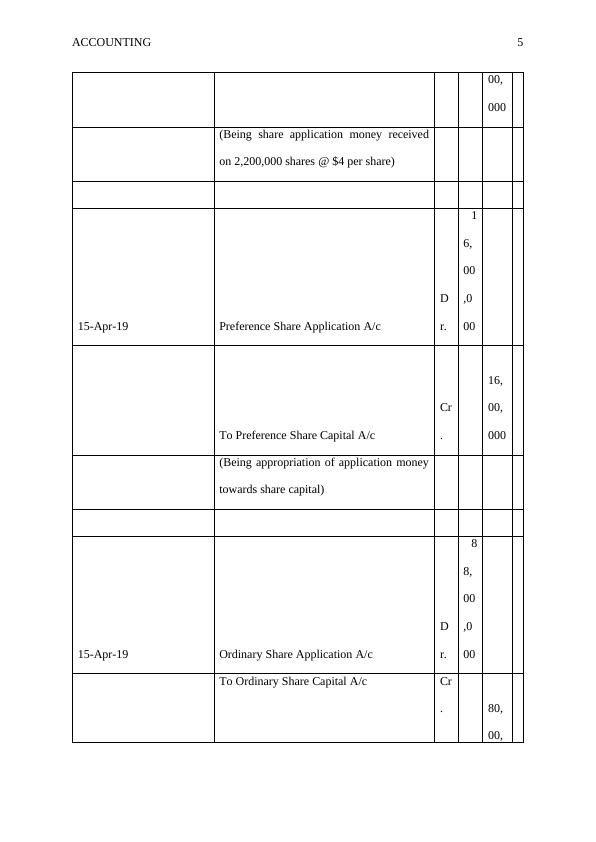
ACCOUNTING 6
000
To Amount Due on allotment of Ordinary
Shares
Cr
.
8,0
0,0
00
(Being appropriation of application money
towards share capital on 2,000,000 shares
and excess money towards amount due on
allotment on 200,000 shares)
15-May-19 Ordinary Share Allotment A/c
D
r.
3
0,
00
,0
00
To Ordinary Share Capital A/c
Cr
.
30,
00,
000
(Being allotment money due on 2,000,000
shares @ $ 1.50 per share)
15-May-19 Bank A/c D
r.
2
2,
00
000
To Amount Due on allotment of Ordinary
Shares
Cr
.
8,0
0,0
00
(Being appropriation of application money
towards share capital on 2,000,000 shares
and excess money towards amount due on
allotment on 200,000 shares)
15-May-19 Ordinary Share Allotment A/c
D
r.
3
0,
00
,0
00
To Ordinary Share Capital A/c
Cr
.
30,
00,
000
(Being allotment money due on 2,000,000
shares @ $ 1.50 per share)
15-May-19 Bank A/c D
r.
2
2,
00
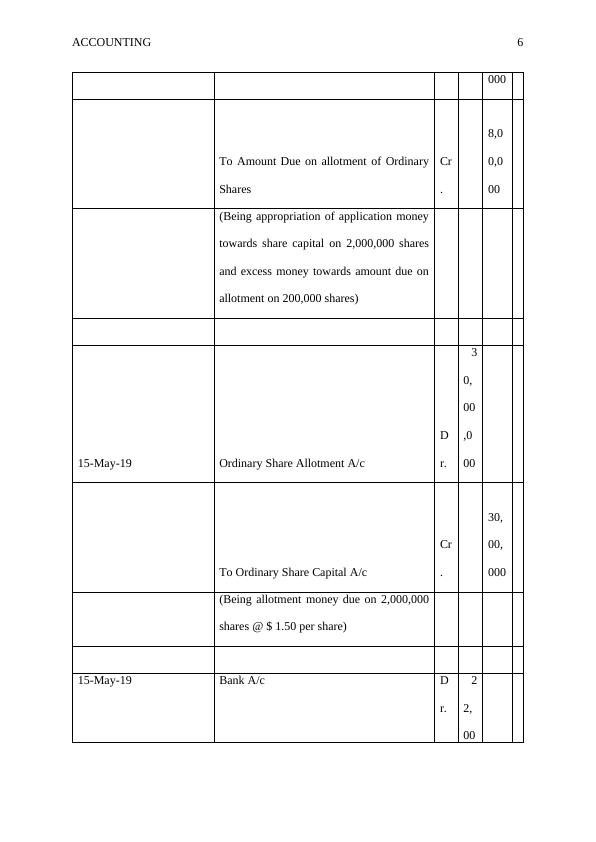
End of preview
Want to access all the pages? Upload your documents or become a member.
Related Documents
Accounting: Provision, Change in Accounting Estimate, Income Taxes, Fixed Assetslg...
|29
|2847
|478
Calculation of Taxable Incomelg...
|11
|1807
|53
Financial Accountinglg...
|13
|609
|67
Financial Accounting: Provisions, Contingent Liabilities, and Contingent Assetslg...
|11
|1388
|41
Corporate Accounting System Assignmentlg...
|16
|2650
|111
Assignment On Corporate Accounting of DJB limitedlg...
|15
|2434
|193
